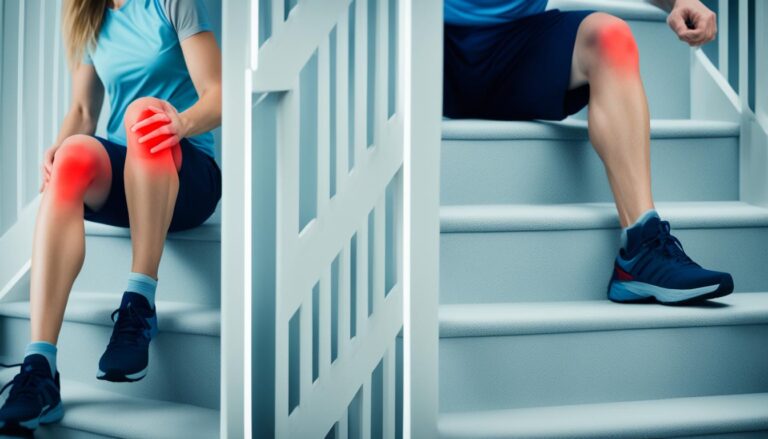Right Way For Managing Knee Pain: by Professional
Our knees are fundamental to our mobility and daily activities. Yet, knee pain is a widespread issue affecting millions worldwide. This comprehensive guide will delve into the causes, symptoms, and treatments for knee pain, providing you with the knowledge to better understand and manage this common condition.
Introduction
Knee pain is a pervasive problem that doesn’t discriminate by age or lifestyle. Whether you’re an athlete pushing your limits, an office worker with a sedentary job, or somewhere in between, knee pain can strike and significantly impact your quality of life. Understanding the complexities of knee pain is crucial for effective management and treatment.
According to recent studies, approximately 25% of adults suffer from frequent knee pain. This staggering statistic underscores the importance of knee health education and proactive care.
[Image: Anatomical diagram of a knee] Alt text: Detailed anatomical diagram showing the structure of a human knee joint
Anatomy of the Knee
To truly understand knee pain, we must first explore the intricate anatomy of the knee joint.
Basic Structure
The knee is one of the largest and most complex joints in the human body. It consists of:
- Bones: The femur (thighbone), tibia (shinbone), and patella (kneecap)
- Cartilage: Including the meniscus, which provides cushioning between bones
- Ligaments: Connect bones and provide stability (e.g., ACL, PCL, MCL, LCL)
- Tendons: Connect muscles to bones (e.g., patellar tendon)
- Bursae: Small fluid-filled sacs that reduce friction between tissues
Function of Each Component
- Bones: Provide the structural framework and enable movement
- Cartilage: Acts as a shock absorber, reducing friction between bones
- Ligaments: Stabilize the joint and guide motion
- Tendons: Allow muscles to move the joint
- Bursae: Reduce friction and provide smooth movement
The knee’s design allows for a range of motions, including flexion, extension, and a small degree of rotation. This complexity, while providing great functionality, also makes the knee susceptible to various types of injuries and conditions.
[Image: Labeled diagram of knee anatomy] Alt text: Labeled anatomical diagram of a knee showing bones, cartilage, ligaments, and tendons
Common Causes of Knee Pain
Knee pain can result from a wide array of factors, ranging from acute injuries to chronic conditions. Understanding these causes is crucial for proper diagnosis and treatment.
Injuries
- Sprains and strains: Overstretching or tearing of ligaments or muscles
- Meniscus tears: Damage to the cartilage that cushions the knee joint
- Ligament tears: Such as ACL (Anterior Cruciate Ligament) or MCL (Medial Collateral Ligament) injuries
- Fractures: Breaks in the kneecap, lower femur, or upper tibia
Arthritis
- Osteoarthritis: The most common form, caused by wear and tear of cartilage
- Rheumatoid arthritis: An autoimmune condition that causes joint inflammation
- Post-traumatic arthritis: Develops after an injury to the knee
Overuse Conditions
- Tendinitis: Inflammation of tendons, often due to repetitive activities
- Bursitis: Inflammation of the bursae, frequently caused by prolonged kneeling
- Patellofemoral pain syndrome: Pain around the kneecap, common in runners
Other Causes
- Gout: Build-up of uric acid crystals in the joint
- Infections: Bacterial or viral infections in the joint or surrounding tissues
- Osgood-Schlatter disease: Common in adolescents, causing pain below the kneecap
- Iliotibial band syndrome: Common in runners, causing outer knee pain
[Image: Infographic showing percentage breakdown of common knee pain causes] Alt text: Pie chart illustrating the percentage distribution of common causes of knee pain
Statistics on Knee Pain Causes
I have created a detailed table showing the prevalence of different causes of knee pain, including the age group most affected, common symptoms, and potential treatments. If you need any further modifications or additions, please let me know!
These statistics highlight the significant role that degenerative conditions like osteoarthritis play in knee pain, while also showing the substantial impact of acute injuries.
Symptoms Associated with Knee Pain
Knee pain can manifest in various ways, and understanding these symptoms can help in early identification and treatment.
Types of Pain
- Sharp pain: Often associated with injuries or meniscus tears
- Dull ache: Common in chronic conditions like arthritis
- Burning pain: May indicate nerve issues or inflammation
- Throbbing pain: Could be related to fluid buildup or inflammation
Other Symptoms
- Swelling: Indicates inflammation or injury
- Stiffness: Common in arthritis or after periods of inactivity
- Instability: Feeling like the knee might give way, often due to ligament issues
- Locking: The knee gets stuck in one position, often due to a meniscus tear
- Popping or crunching noises: May indicate cartilage wear or loose bodies in the joint
Warning Signs
- Severe pain or swelling
- Inability to bear weight
- Visible deformity
- Fever accompanying knee pain
- Redness and warmth around the joint
It’s important to note that symptoms can vary greatly depending on the underlying cause. For instance, osteoarthritis pain often worsens with activity, while rheumatoid arthritis may cause more pain in the morning.
[Image: Photo series showing visual symptoms like swelling] Alt text: Series of photos showing different visual symptoms of knee problems, including swelling and redness
Diagnosis of Knee Pain
Accurate diagnosis is crucial for effective treatment of knee pain. Healthcare providers use a combination of methods to determine the underlying cause.
Physical Examination
A thorough physical exam is often the first step in diagnosis. This may include:
- Assessment of range of motion
- Palpation for areas of tenderness
- Stability tests to check ligament integrity
- Gait analysis to observe walking patterns
Imaging Tests
Various imaging techniques can provide detailed views of the knee structures:
- X-rays: Show bone structure and alignment, useful for diagnosing fractures or arthritis
- MRI (Magnetic Resonance Imaging): Provides detailed images of soft tissues, excellent for diagnosing ligament or meniscus injuries
- CT (Computed Tomography) scan: Offers cross-sectional images of the knee, useful for complex fractures
- Ultrasound: Can show real-time images of tendons and ligaments in motion
Other Diagnostic Procedures
- Blood tests: To check for infections or inflammatory conditions
- Arthroscopy: A minimally invasive surgical procedure to view inside the joint
- Synovial fluid analysis: Examination of fluid from the joint to diagnose infection or gout
The choice of diagnostic tools depends on the suspected condition and the information needed to make an accurate diagnosis.
[Image: Doctor examining a patient’s knee] Alt text: Healthcare professional performing a physical examination of a patient’s knee.
Treatment Options
Treatment for knee pain varies widely depending on the underlying cause, severity of symptoms, and individual patient factors. Here’s an overview of common treatment approaches:
Non-surgical Treatments
- Rest and activity modification
- Avoiding activities that exacerbate pain
- Using assistive devices like canes or crutches when necessary
- Physical therapy and exercises
- Strengthening exercises for muscles supporting the knee
- Flexibility exercises to improve range of motion
- Balance and proprioception training
- Medications
- Non-steroidal anti-inflammatory drugs (NSAIDs) for pain and inflammation
- Acetaminophen for pain relief
- Topical medications like creams or patches
- Corticosteroid injections for severe inflammation
- Braces and supports
- Knee sleeves for compression and support
- Functional braces to support unstable knees
- Unloader braces for arthritis
- Alternative therapies
- Acupuncture
- Massage therapy
- Cold and heat therapy
Surgical Treatments
When non-surgical treatments fail to provide relief, surgical options may be considered:
- Arthroscopy
- Minimally invasive procedure to repair damaged cartilage or ligaments
- Remove loose bodies in the joint
- Knee replacement
- Partial knee replacement: Replaces only the damaged part of the knee
- Total knee replacement: Replaces the entire knee joint
- Other surgical procedures
- Osteotomy: Realignment of the knee to relieve pressure
- Cartilage grafting: To repair damaged cartilage
- Synovectomy: Removal of inflamed synovial tissue
The choice of treatment depends on various factors, including the patient’s age, activity level, overall health, and the specific condition causing the knee pain.
[Image: Collage of various treatment methods] Alt text: Collage showing different knee pain treatment methods including medication, physical therapy, and surgery .
Home Remedies and Self-Care
Many knee pain issues can be effectively managed at home, especially in the early stages or for mild cases.
RICE Method
The RICE method is a well-established approach for managing acute knee injuries:
- Rest: Avoid activities that aggravate pain
- Ice: Apply cold packs for 15-20 minutes every 2-3 hours to reduce swelling
- Compression: Use an elastic bandage to minimize swelling
- Elevation: Raise the leg above heart level to reduce blood flow and swelling
Gentle Exercises and Stretches
- Low-impact activities like swimming or cycling to maintain fitness without stressing the knee
- Stretching exercises to improve flexibility of muscles around the knee
- Strengthening exercises for quadriceps, hamstrings, and calf muscles
Proper Footwear and Posture
- Wear shoes that provide good support and cushioning
- Use orthotic inserts if recommended by a healthcare provider
- Maintain good posture to reduce stress on knees
<Weight Management
Maintaining a healthy weight is crucial for knee health. Every pound of weight lost reduces the load on the knee by about 4 pounds during walking.
Dietary Considerations
- Consume anti-inflammatory foods like fish, nuts, and leafy greens
- Stay hydrated to maintain joint lubrication
- Consider supplements like glucosamine and chondroitin (consult with a doctor first)

Prevention Strategies
Preventing knee pain is often easier and more effective than treating it. Here are some strategies to maintain healthy knees:
Maintain a Healthy Weight
Excess weight puts additional stress on your knees. Losing weight if you’re overweight or maintaining a healthy weight can significantly reduce your risk of knee pain and osteoarthritis.
Exercise Regularly
- Engage in low-impact exercises like swimming, cycling, or elliptical training
- Incorporate strength training to build muscles that support the knee
- Practice flexibility exercises to maintain good range of motion
Use Proper Technique
- Always warm up before and cool down after exercise
- Learn and use proper form during physical activities
- Gradually increase the intensity and duration of your workouts
Protect Your Knees
- Wear appropriate protective gear during sports or high-risk activities
- Use knee pads when kneeling for prolonged periods
Listen to Your Body
- Don’t ignore pain or discomfort in your knees
- Take breaks and rest when needed
- Modify activities that cause knee pain
Maintain Good Overall Health
- Stay hydrated to keep joints lubricated
- Eat a balanced diet rich in nutrients that support joint health
- Get enough sleep to allow your body to recover and repair
[Image: Person demonstrating proper exercise form] Alt text: Individual demonstrating proper form for knee-strengthening exercises
When to See a Doctor
While many cases of knee pain can be managed at home, there are situations where professional medical attention is necessary. Seek medical care if you experience:
- Severe pain or swelling
- Inability to bear weight on the affected leg
- Visible deformity of the knee or leg
- Signs of infection (fever, redness, warmth around the knee)
- Pain that persists for several days despite home care
- Instability or giving way of the knee
- Locking of the knee joint
- Numbness or tingling around the knee
Remember, early intervention can often prevent more serious problems from developing.
[Image: Infographic of warning signs] Alt text: Infographic listing key warning signs that indicate when to seek medical attention for knee pain
Living with Chronic Knee Pain
For some individuals, knee pain becomes a chronic condition. Learning to live with ongoing knee issues requires a multifaceted approach:
Lifestyle Adjustments
- Modify your home or workplace to reduce stress on your knees
- Use assistive devices when necessary (canes, walkers, raised toilet seats)
- Adapt your activities to accommodate your knee condition
Pain Management Techniques
- Learn relaxation techniques like deep breathing or meditation
- Consider cognitive behavioral therapy to manage pain perception
- Explore alternative therapies like acupuncture or tai chi
Emotional and Psychological Considerations
- Recognize the emotional impact of chronic pain
- Seek support from friends, family, or support groups
- Consider counseling if you’re struggling with depression or anxiety related to your knee pain
Stay Active
- Work with a physical therapist to develop a safe exercise routine
- Focus on low-impact activities that don’t exacerbate your knee pain
- Maintain social activities and hobbies as much as possible
Ongoing Medical Care
- Attend regular check-ups with your healthcare provider
- Be proactive about discussing new treatments or management strategies
- Stay informed about advancements in knee pain treatment
Living with chronic knee pain can be challenging, but with the right approach, many people can maintain a good quality of life and continue to engage in meaningful activities.
[Image: Person using assistive devices] Alt text: Individual using a cane or walker to assist with mobility due to knee pain
Conclusion
Knee pain is a complex issue that affects millions of people worldwide. By understanding the anatomy of the knee, recognizing common causes and symptoms of knee pain, and familiarizing yourself with various treatment and prevention strategies, you can take proactive steps to maintain healthy knees and manage pain effectively when it occurs.
Remember that each person’s experience with knee pain is unique, and what works for one individual may not work for another. It’s essential to work closely with healthcare professionals to develop a personalized approach to knee health and pain management.
By implementing preventive measures, seeking timely medical attention when needed, and following appropriate treatment plans, you can optimize your knee health and maintain an active, fulfilling lifestyle. Your knees play a crucial role in your mobility and independence – taking care of them is an investment in your overall quality of life.







